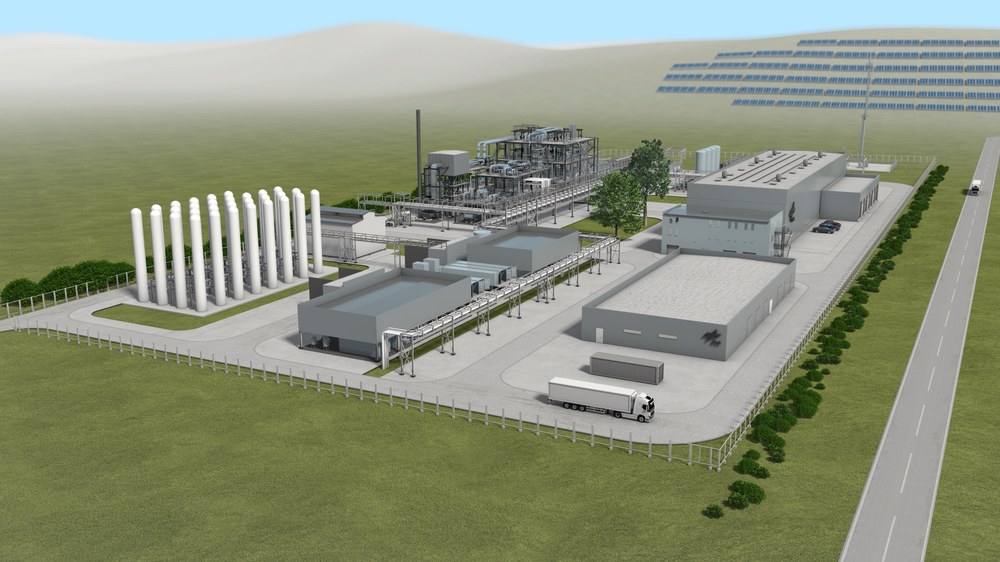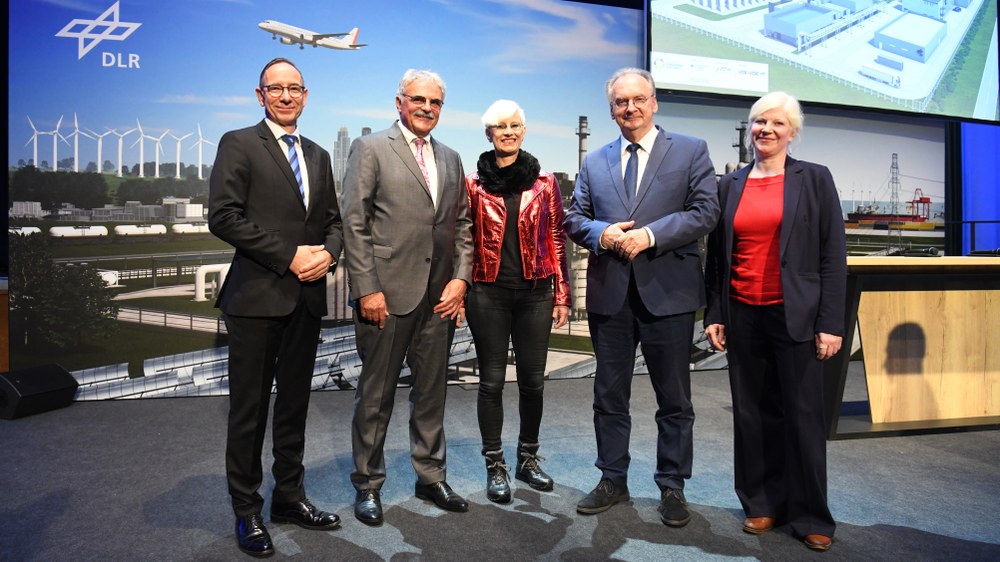PtL technology platform – looking to the future


- Electricity-based fuels will make an important contribution to improving the environmental and climate impact of air transport in particular, as well as shipping and land transport.
- In order to develop technologies for the industrial production of these fuels, DLR is building a unique research and demonstration facility.
- The Power-to-Liquid fuels technology platform (TPP) will be located in Leuna, Saxony-Anhalt, Germany.
- Focus: Aviation, energy, climate-friendly flying, PtL, e-SAFs, e-fuels
With the Technology Platform Power-to-Liquid Fuels (TPP), the German Aerospace Center (Deutsches Zentrum für Luft- und Raumfahrt; DLR) is building a research and demonstration facility in Leuna, Saxony-Anhalt, that is unique in form and size, using funding from the German Federal Ministry for Digital and Transport (BMDV). The focus is on technologies and large-scale processes for producing electricity-based fuels – also known as Power-to-Liquid fuels (PtL) – on an industrial scale and in a timely manner. On 16 October 2023, DLR announced the plan for the technology platform in Leuna, which is to be built from 2024 on a site of just under five hectares at the Leuna Chemical Complex.
The BMDV has made up to 12.7 million euros available for this planning phase. Approval for the implementation phase, with a budget amounting to mid-three-digit million euros, is expected at the end of the year. Operation of the research facility is initially planned until 2035, with continued operation envisaged beyond this time. Approximately 100 jobs will be created in the fields of construction, plant operation and research.

Animation: PtL technology platform (TPP) – an overview of the central components
Your consent to the storage of data ('cookies') is required for the playback of this video on Quickchannel.com. You can view and change your current data storage settings at any time under privacy.
"Air transport is indispensable in a free and globalised world," said Chair of the DLR Executive Board, Anke Kaysser-Pyzalla, at the event in Leuna. "That is why e-fuels are an important building block for improving the climate and environment impact of mobility solutions in the future. With the TPP, DLR will develop and demonstrate the necessary technologies together with renowned industrial companies and research institutions in order to lay the groundwork for industrial production. This will also create unique expertise, with which we will further strengthen Germany as a location for technology and business."
"With this technology platform for Power-to-Liquid fuels funded by the BMDV, the world's largest research facility for the production of PtL fuels is being built in Leuna – at a location with important industrial tradition in the heart of the Federal Republic of Germany," said Daniela Kluckert, Parliamentary State Secretary to the Federal Minister for Digital and Transport. "This is not only an honour for the region, but for Germany as a location for research and industry. We want to lead the way internationally and create optimal conditions for the market ramp-up of e-fuels. The new research facility will make a decisive contribution to the development and application of technologies necessary for the industrial production of e-fuels. The establishment of this platform is a significant milestone on the way to sustainable and environmentally compatible mobility."
Minister President Reiner Haseloff emphasised: "Saxony-Anhalt is the ideal location for this technology platform for e-fuels. We have a modern and efficient chemical industry with over a hundred years of experience. We are leaders in the use of renewable energies and are home to outstanding research institutions. The technology platform is an important building block for successful structural change in the region. In the coming years, Saxony-Anhalt will lay the essential foundations for shaping the energy transition in Germany. This is something we can be proud of."
"The industrial environment and the professional infrastructure and services at the Leuna chemical site will help enable these renewable fuels to transition from the pilot plant into active production," explained Christof Günther, Managing Director of the site operator InfraLeuna GmbH. "The selection of the Leuna site by DLR from more than 60 applicants provides us with motivation for the further transformation towards sustainability and the active linking of research, development and industrial practice. In addition to biotechnology, the Leuna site will become a leading technology operator in Europe in another promising field of chemical production."
Largest research facility to date for industrial production of e-fuels
The PtL technology platform consists of two elements that complement one another: the demonstration element focuses on the campaign operation of a semi-industrial plant for the production of e-fuels. Its capacity is up to 10000 tonnes per year. Currently, this would make the TPP the world's largest research facility in the field of e-fuels. The demonstration element will enable researchers to investigate how production processes can be scaled up as efficiently as possible to a semi-industrial level and how operating parameters can be optimised.
The TPP demonstration element will initially produce hydrogen from renewable electricity and water by means of electrolysis. The electricity comes exclusively from renewable sources such as wind and photovoltaics and meets the strict sustainability criteria of the European Union's Renewable Energy Directive (RED II). If needed, the hydrogen will be temporarily stored in large storage tanks with a capacity of 24 hours of full-load operation. It will then be converted into a synthesis gas using carbon dioxide from the air and biogenic sources such as biogas plants or biomass boilers. This will be followed by a process called Fischer-Tropsch synthesis. In this process, which has already reached industrial maturity, a synthetic, electricity-based crude oil is produced from the synthesis gas. Due to the different chemical composition, petroleum processing methods cannot be directly transferred to this synthetic, electricity-based crude oil obtained from renewable resources, called syncrude. Therefore, the subsequent processing into standardised fuels must also be adapted and optimised to the properties of the syncrude. The fuels obtained can then be used for climate-friendly aviation, in particular, as well as shipping and land transport.
The research element – with a capacity of 100 tonnes per year – will enable DLR to work with scientific institutions and industrial partners to further develop innovative technologies and test new approaches to improve production processes and the properties of the fuels produced. DLR is also investigating how e-fuels can also be produced using 'green' methanol.
Fuel design – targeted fuel development also reduces non-carbon-dioxide effects
E-fuels have the potential not only to greatly reduce carbon dioxide production, but also to significantly reduce the non-carbon-dioxide effects of fuel use. These include the emission of nitrogen oxides, soot particles and water vapour. In aviation, the climate impact of these non-carbon-dioxide effects is currently significantly greater than the climate impact of the carbon dioxide generated. For example, soot particles and water vapour can lead to the formation of contrails in the atmosphere, which have an additional warming effect. In this context, e-fuels offer another advantage: their design can be customised. This means that the chemical composition of these fuels can be optimised in such a way that, for example, no soot or fine dust is produced during the combustion process.

Federal Ministry for Digital and Transport, NOW, VDI-VDE-IT
The Technology Platform Power-to-Liquid Fuels (TPP) project's planning phase is being funded by the Federal Ministry for Digital and Transport with a total of 12.7 million euros as part of its 'Renewable Fuels' concept. The development platform for PtL fuels is coordinated by NOW GmbH and implemented by the project management organisation VDI/VDE Innovation + Technik GmbH.
Related articles
What are electricity-based fuels?
Electricity-based fuels – also referred to as e-fuels or Power-to-Liquid (PtL) fuels – are liquids. To produce them, carbon is used, for example from the air, and hydrogen, which is obtained by means of electrolysis. If the electricity used is produced using renewable resources such as wind or solar energy, the fuels produced in this way are climate neutral. This means that they only release as much carbon dioxide during the combustion process as was previously captured during their manufacture.
In the long term, many mobility sectors will be dependent on large quantities of liquid energy sources. These include air transport and shipping in particular, but also vehicles that cannot be easily electrified because they are very heavy or have to cover long distances.
Another advantage of electricity-based fuels is that they can be transported, distributed, stored and used largely with existing infrastructure and vehicles or aircraft.
